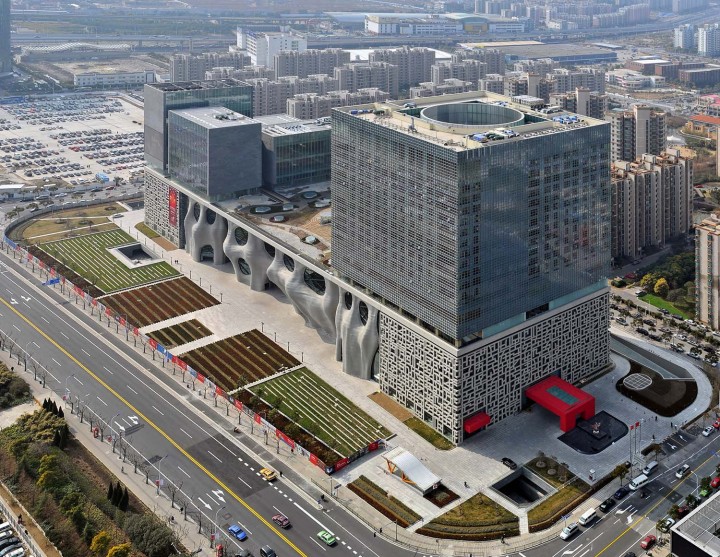A historical nexus of China’s cultural avant-garde, Shanghai is now a burgeoning hub for the contemporary art industry. In the fall of 2016, the city will host the first edition of the Shanghai Project, a multifaceted cultural event that intends to rethink the format of the biennial in order to adapt it to the fluid nature of megacities. Flash Art talks with Yongwoo Lee, Shanghai Project’s initiator.
The Gwangju Biennale, one of the most important cultural events in the world, was your creation. What are your expectations for the Shanghai Project?
My work with the Gwangju Biennale was dedicated to advancing both contemporary art and the biennial as a form of social practice. I wanted to make Gwangju a type of forum where people can come together, communicate and participate in creating new forms of aesthetic and cultural expression as well as cross-cultural engagement and dialogue. The Shanghai Project departs from the biennale form in a number of ways — from the structure of the institution to the geographical and cultural context in which it is situated. Shanghai is one of the largest and fastest-growing cities in the world, and it is constituted by a majority of migratory populations. Hence the engagement with the social matrix of Shanghai will require different practices, conceptual tools and frames of reference to understand and harness its creative force.
The conference “Ní hăo, Shanghai!,” planned as our initial in-depth conversation with visual artists, filmmakers, architects, scholars, critics and curators about the city as space, myth, image and state, will set the ground for our year-long investigation.
Despite these important differences, my expectations for the Shanghai Project remain focused on further developing the art exhibition platform as a social practice that is both dynamic and stable. I hope that the Shanghai Project will be able to reach out to the constituents of Shanghai and provide a space to look out on and participate in the wider world of global art and culture that has been increasingly looking in.
How will the Shanghai Project differ from other biennials and festivals?
The biennale form has been continually evolving since its eruption onto the world stage in the 1990s. The Shanghai Project will be an important step in this evolution of biennales and other international art events into new hybrid, interdisciplinary and reflexive modes of exhibition making. In so far as biennales have become a leading type of art institution, and one of the most globally constituted, it is imperative that this inherently ephemeral and chameleonic institution continuously reconstitutes itself to not only capture and reflect back on the changing images of people and places such as the megacity of Shanghai but also to interact with such transient social and cultural matrices in a way that leads to meaningful transformations for the diverse groups and individuals involved.
The Shanghai Project will experiment with the actual structure of the biennale, developing not only a new “platform” or “laboratory” but also the rules, guidelines and methodology of this laboratory. In addition, all participants, from both Shanghai and abroad, will be designated as researchers, and convened in small groups to develop an expansive conversation. The ideas and methods generated from these teams of researchers, composed of practitioners from various fields, will form the basis for exhibitions, shows, performances and publications. However, these innovations are not intended to be fixed. Rather, they can change with every edition, with each artistic director and his or her team of collaborators. In particular, this first edition of the Shanghai Project will be launched in part as a platform to develop the Shanghai network of institutions, independent spaces and “free agents” (which can also include artists, architects, designers, scientists, historians, critics, etc.). The Shanghai Project can foster increased levels of professionalism for this network by providing administrative support and resources to fledgling cultural projects. Functioning as an inclusive platform for all the museums and art spaces in Shanghai, the Shanghai Project will be able to further expand the “Shanghai network” by making connections and developing projects that were not possible before.
In terms of energy and dynamism, many consider Shanghai to be the Asian equivalent of New York. How would you characterize it? Is Shanghai becoming a hub for contemporary art akin to New York?
Although the common comparison between Shanghai and New York is a predominant one, it is one among many possible comparisons. Interestingly, as the historian Jeffrey Wasserstrom has pointed out, it is Budapest that presents the most similarities with Shanghai in so far as both are “re-globalizing post-socialist cities.” The comparison of cities is all to often a dangerous and reductive undertaking. More importantly, I think any question that touches on Shanghai or any city’s capacity to function as a hub for contemporary art needs to address the importance of the historical-geographical specificity of its publics. The people and institutions that comprised New York in the postwar period are not comparable to those of contemporary Shanghai. The knowledge regimes of today are also quite different from 1950s New York. A large part of our project will be dedicated to examining these very questions, with as much intellectual rigor as human sensitivity.
How will the Shanghai Project affect the cultural fabric of the city?
One of the principle goals of the Shanghai Project is to help make new and old Shanghai residents aware of the artistic and cultural resources that are available and rapidly expanding in their city. We would like to extend the reach (as well as translate the mediums) of current cross-disciplinary dialogues to embrace the multiple publics of Shanghai in ways that are not only accessible to them but can also be taken up to articulate different outlooks and needs.


